|
Sunday, June 4 was the official start of the
Tano Festival.
The festival grounds were filled up with vendors who were open and doing
business as early as Saturday, but the religious part didn't start until Sunday night. I spent Saturday day wandering around looking at everything, and really spending much more money than I had planned to on the first day. I was going to look at everything the first day, compare prices the second day, and shop the third day. Oh well, so much for plans.
There were a couple of interesting things. One guy had a wonderful demonstration going on for a Kimbap roller. Kimbap (or kimpap, or kimbab) could be described as Korean sushi. It's got the rice and seaweed in common, but whereas sushi usually has some sort of raw fish, Koreans throw in everything but the kitchen sink. Anyway this kimbap roller was so spiffy I bought myself one. Then there was a lady selling "rice covers." Basically, it's a cloth to put over your food to keep the flies off. As best as I could tell from what little I could understand, they were made of leftover fabric from sewing hanbok. So I bought a bunch of the rice covers. I've been eyeing hanbok in the stores ever since I got here, and they run $200-300 easy. So when I found a hanbok that looked nice and was comfortable fabric and fit, for only 30,000 won (less than US$30), I bought that too. It's a winter one, so I can't wear it for a while, but I'll get a lot of good use out of it. The whole thing reminds me a lot of the Summit county fair -- lots of vendors and food, a couple of rides (but nothing like home), and entertainment. The entertainment's a little different; instead of a demolition derby, there's Korean sumo wrestling, and there'll be various types of traditional performances.
The official, religious Tano festivities started Sunday morning at about 9:00. There were fireworks and then a parade headed by the mountain god in the guise of a tree. (See the Tano Webpage for more information on how the god got into the tree). He was all surrounded by Shaman priestesses, and Confucian religious men, and followed by musicians and people carrying Tano lanterns. I followed the parade to the platform where the god was supposed to preside over Tano, and they set him up and started a ceremony that involved priestesses singing and dancing, while the Confucian men did something at the altar. Then people started that complicated bowing, one or two at a time.
The priestesses were singing and dancing, with drummers playing along, the whole while (click the player icon under the picture to hear a little of it). It was pretty intriguing to watch them. One would sing for a while, and then one would snatch the mike out of her hand and sing for a while (the snatchee never looked upset about it, she'd just dance around) and then another one would dance up and snatch the mike. Maybe each one had a part of the story to tell. In any case, it was all well worth seeing. After the ceremony I was approached by, of all things, a foreigner -- one of the few I've seen in Kangnung, and the first one I've actually met. Her name is Linda, she's from New Zealand, and she teaches at a hagwon in another part of town. She got to Korea 11 days after I did, and I don't think she's adjusting as well as I did. Too many things about the culture seem to rub her the wrong way. She's very open about being a lesbian, which is courageous in a country which usually isn't very friendly toward gays and lesbians. She works longer hours than I do, and doesn't seem to have as good a relationship with her boss as I have with mine. I'm very glad that I'm where I am. I think she mostly hangs out with other foreigners. In many ways I'm lucky not to have had the opportunity to do that. I can see how it would be very easy to do, and not really experience all of what Korea has to offer. But it was fun to talk to her.
I was going to go to Tano again Monday morning before work, but when I told Mrs. Kim about my spiffy kimbap roller she suggested that I should bring kimbap in to work some time. I was kind of wanting to play with it anyway, so I made kimbap today. I obviously need more practice, since I broke a lot of them; but I did get a nice little platter made up to take in, and I'll be eating the rejects myself for the next couple of days. At any rate, I missed Monday's events entirely.
|
|
Tuesday the 6th was a holiday, so I had all day to spend at
Tano.
I was going to stay until close, but did too much shopping and wussed out
when the packages got too heavy to carry around for another 6 hours.
I wasn't planning on shopping at all
Tuesday. I was just going to watch all the shows, and maybe shop
I bought some presents, and another hanbok, and some hangers to hang up my hanboks, and some kim so I could make more kimbap, and more presents, and a little crocheted rabbit doll for Bear, and a little folding stool so I could have something to sit on to watch more shows. And of course by then it all weighed so much that all I wanted to do was take it home and drop it off. The plan was to go back afterwards, but I had Mrs. Lee over, and then it got to be 9:00 and I just didn't feel like heading out again. Walking around in the heat does wear me down. It was at least 33° C (91° F) today.
|
|
Anyhow, before my body objected to sitting so uncomfortably for so
long, I did get to see a lot of things. The reason I went so early was to
see the morning sacrificial ritual, or Chojonje, to the mountain god. I told Mrs. Lee that was
my plan yesterday, and we joked about it being human sacrifice. "Look,
there's a foreigner! Let's use her!" Actually it was the usual: dried
fish, rice cakes, a watermelon, a couple of plastic liter bottles of
soju.
|
There was an older gentleman in a blue hanbok (the Confucian costumes were black) directing them when to go to the altar, when to bow, when to get up from the bow, and putting their hats and belts back on when they fell off. I felt like I was watching a Lions Club or something that had volunteered to fill in for the day. According to the Tano Festival literature, this was Kim Chin-Dok, "important government-designated intangible cultural asset no. 13 who is an expert in ceremonial formalities." It's interesting to see the differences between the way our government and the Korean government handle religion. In Korea, instead of being completely isolated from religion, they seem to try to support all the religions equally. The audience was packed in around the performance area, sitting on the floor. Those who were trying to be proper had a piece of newspaper or cardboard to sit on, and those who didn't care or were just tired of standing (like me) were just sitting on the bare floor. I stood in the back for about 45 minutes, and just didn't want to stand anymore, so when a spot cleared out and no one else claimed it, I did. It's funny that people don't quickly claim a spot that clears out unless you count the fact that whoever is behind that spot spreads out her legs (the crowd was almost entirely old women) into it. But if they want to sit down, they just plow through the crowd and force a place for themselves. Anyhow, picking their way through this crowded floor were half a dozen or so people selling ice cream, yogurt (liquid yogurt to drink -- I haven't seen it at home, but it's pretty good), candy, snacks, and of all things safety pins and strips of rubber (like cut rubber bands, only about 6 feet long -- I haven't figured out yet what they do with them). Towards the end of the Confucian ritual people started filing in to bow at the altar and do the paper-burning thing. You make a monetary offering and a priestess lights a piece of paper in the candle, burns it almost all the way, and lets go. If the ash rises well it means your prayer is favorably answered. This continued throughout the Shaman ritual and as far as I could tell for the rest of the day. That mountain god has his work cut out for him. After the Confucian ritual was over they took off all their Confucian outerwear right there on stage as it were, and took down all the sacrificed food and handed it out on plates to the crowd, except for some sort of white stuff in a bowl (rice something I expect, but not plain rice). That was just taken out of the bowl in great handful chunks and handed to people, who broke off smaller chunks and handed them around. It was soft enough to come apart easily and firm enough to keep its shape, even when one of the guys started tossing it over the crowd to the people in the back. I didn't get to experience it personally, which is a shame, because I'm very curious about it. It was very popular -- everybody wanted some. The men were very funny out of their black clothes. They had hanbok on underneath of course, but it was hot, so they were very light hanbok, quite transparent. So one guy's cigarette packs were clearly visible through his pocket, another's chest was visible, and another one had on blue underpants which showed clearly through his white hanbok. This made them look even more like guys from the Lions Club. While some were handing out food, others were packing up, and they made a huge tower of wooden boxes, copper kettles and lacquer tables which they then proceeded to tie together with a very long cloth. It was perhaps 7 feet tall. I thought this was for carrying purposes, and eventually they did get it tied securely enough to pick it up and move it. But they only moved it to center stage, and then put a red and gold coat and hat on it. Maybe the clothes were supposed to be the village chief for the satirical play, Wonnimnori, which is part of the Shamanist service.
|
Then it was time for the
I felt sorry for the main priestess. That mountain god is working her altogether too hard; she had practically no voice left. There were 3 priestesses that sang, and others that burned papers, but one was obviously no. 1. So she started off the ritual singing and dancing to the tower of objects, and very picturesque she was, too. She'd just gotten started when some guy in the back corner started pointing his finger at her and screaming at her. He was soon joined by a few others. At first I wasn't sure if he was just going into some pagan throes or what, but then I decided that he was a Christian looney tunes protester. It's a shame that it's so often the intolerant versions of Christianity that do the missionarying, because that just sets up situations like this. It really gives Christianity a bad name. The poor priestess tried to ignore him and carry on, but he kept screaming at her and pointing his finger at her, and eventually she started screaming back. Then he started coming towards her through the crowd, and some guy tried to shove him back, and they got into a fight right where I was sitting. I tried to get a picture, but they were too close to get a good one, so I decided discretion was the better part of valor and moved out of the way. A lot of people vacated at that time, and I was able to get a much better seat. Anyhow, the authorities managed to eject the main protester, and the priestess carried on with the program. She went back to singing and dancing to the tower of objects, and eventually started twitching and taking off her top layer of clothes. I suspect this is when she was possessed by the mountain god -- at least that's what's supposed to happen. And then she leaned towards the tower of objects and bit it, and lifted the whole tower with her teeth. And it can't have been light. The other priestesses untied the tower and started removing parts, and that finally left her with a large kettle that she was holding by the handle (a side handle) with her teeth. This was apparently the signal for the other priestesses to take kettles too, only in their hands, and join the snack vendors in making their way through the crowd taking a collection. I threw in a couple thousand won (about US$1.80) -- they sure had earned it. Then they went back on "stage" and took turns singing after wresting the kettle from the one priestess's mouth. I watched for a while longer and then wandered off.
|
 I saw a little bit of a lot of things. There was a contest where girls were
tossing arrows into metal pipes. They were very cute in their hanbok and
baseball caps. There was wrestling (Ssirum). The boys just wear shorts and have a
blue cloth tied around their waists. They crouch down and grab each
I saw a little bit of a lot of things. There was a contest where girls were
tossing arrows into metal pipes. They were very cute in their hanbok and
baseball caps. There was wrestling (Ssirum). The boys just wear shorts and have a
blue cloth tied around their waists. They crouch down and grab each
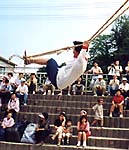 other's cloths, and at the go signal, see who can throw the other to the
ground first. The match I saw was very unequal. One boy was much bigger
than the other, and literally picked him up before tossing him down.
other's cloths, and at the go signal, see who can throw the other to the
ground first. The match I saw was very unequal. One boy was much bigger
than the other, and literally picked him up before tossing him down. There were kids on Korean swings (Kune), which are similar to ours only you swing standing up. There was a Chinese Chess contest. There was a guy selling cow horns glued together with a wooden ring through them and a cloth strip with writing on it around the ring. I asked him what they were, hoping he would pick one up and show me what you do with it, but he just told me, so I have no idea. I considered buying one so I could show it to my students and ask them (I thought it would be a neat curiosity to have too), but they were 25,000 won (about US$23), which is a lot to spend on a curiosity.
|
 I got to see Kwannogamyonguk, the masked pantomime dance.
There was a man (Yangban, or the aristocrat), a woman, two good spirits
wearing grey costumes with hula hoops (Sisitaktaki, that is, "those who
prevent misfortune") and two evil spirits wearing black (Changjamari,
or "interrupters"). Now there's another example of how the Korean
government differs from ours. They consider the country's traditional
religions to be part of its folk heritage. Even though the Korean constitution
guarantees freedom of religion, the government doesn't necessarily shy away from
getting involved in preserving traditions just because they're religious. All the actors
in this pantomime were government employees.
I got to see Kwannogamyonguk, the masked pantomime dance.
There was a man (Yangban, or the aristocrat), a woman, two good spirits
wearing grey costumes with hula hoops (Sisitaktaki, that is, "those who
prevent misfortune") and two evil spirits wearing black (Changjamari,
or "interrupters"). Now there's another example of how the Korean
government differs from ours. They consider the country's traditional
religions to be part of its folk heritage. Even though the Korean constitution
guarantees freedom of religion, the government doesn't necessarily shy away from
getting involved in preserving traditions just because they're religious. All the actors
in this pantomime were government employees.They all danced around. The good spirits kept ramming each other with their hula hoops until they both fell down (several times), and the man kept trying to kiss the woman, who would push him away and then turn her back on him and titter.
Well, it happened a few more times. I never figured out if she knew
they were spirits or not, but I got the impression she didn't have a lot
of choice in the matter. Either the spirits made her do it, or she thought
She begged and pleaded, but he kept turning his back on her, so she hanged herself. In the mime she actually wrapped his long beard around her neck.
He didn't notice she was dead (remember he had his back turned on her), but
the spirits did. They
lifted her arm and let it fall, and listened for her heart, and then did
it again and again, probably hoping they were wrong. The game obviously
went farther than they had planned. Finally the good spirits went and got
the aristocrat and dragged him over. And he went through the same routine.
There was much weeping and wailing and gnashing of teeth.
Then the man went and
prayed to the mountain god (a mock-up of the tree at the altar). The
tree began to shake mightily, and went and danced around the woman and
leaped over her a few times and went away. Then the man went and shook her
and she came back to life, and they danced happily together, and the
spirits danced happily together.
All through this obviously very pagan performance we had more Christian protesters. They weren't as bad as the real looney tunes earlier, but were still pretty obnoxious, especially the guy with the bullhorn. He had one of those arrogant holier-than-thou looks about him. There was a whole slew of this batch, most of them carrying signs in Korean, and oddly enough wearing t-shirts that said in English, "Please don't go to hell. Believe in Jesus Christ."
The other show I saw was the Nongak. It's a traditional farmers' dance
stylistically similar to the show we
saw in Seoul, with the huge long streamers on the hats. This had less of the fancy hat
moves and more symbolism. Basically along with the fancy hat moves
The first group was very young. The second group was much older, with the exception of one girl who looked to be perhaps 9 or so. I guess she was there with her grandmother or something. I was proud of her. She danced through that whole interminably long dance in all that heat right in the sun without giving out. I was pretty impressed with the other dancers, too, for that matter. They looked like they were between 70 and 90, and I can't imagine many Americans of that age holding up to that. Maybe that ginseng does something after all. Admittedly there wasn't a lot of vigorous head twirling with the streamers, but one guy had enough energy to throw in leaps and jumps all the way to the end. I was sitting next to a very nice old lady. She saw me sitting on the ground (as many of us were, including her and many other old ladies), and opened up her newspaper so I could sit on it with her, which also allowed me to share her umbrella. They use their umbrellas to keep off sun as well as rain, which saves having to keep a separate parasol. I've considered using mine that way too, but it's just one more thing to carry and juggle around every time I want to take a picture, so I'm going with a hat when necessary (which it is at Tano). Anyway she was very sweet to share space with me, and when her friend brought her frozen fruit juice she shared that with me too. I wished I had some way to return her kindness, but couldn't think of anything. But it was during the second incredibly long dance that my body started objecting, and we were sitting so close together (not full newspaper size -- think "small tabloid") that I couldn't squirm properly. When the dance finally ended, I thanked her profusely and wandered off. So you can see why I bought the little folding stool when I saw it (remember back that far?).
|
|
Wednesday the 7th, I went to the Tano Festival twice -- during the day to look
around, and in the evening with my 8:00 class. We called it a field
trip with "free talk" (English practice). Tano is rather different late at night. It's much more crowded, and if possible there are even more vendors out. I don't know about my two students, but I spent more time trying to keep them in sight than looking at Tano. We did have a good time, though. We got to see several drum performances. This was another competition, between schools. There was an elementary school group which was surprisingly good, and we got to see Mary's students perform. I should mention that my two students are Mary and Carol. Mary teaches English at one of the high schools in town, and Carol teaches English at one of the middle schools. Mary's high school team was really impressive in their playing. She said they won the competition last year, and I expect they won it this year too. We also saw a puppet show. It was very well done, again by students, and using huge numbers of puppets with only about half a dozen performers. It was a story about the overthrow of a bad king.
On our way out we passed
something I had been wondering about. A man was pouring a small brown
puddle of stuff onto a table, which he then pressed into a disk with a
pattern in it. I asked Carol what it was, and she said you try to get the
pattern out of the disk without breaking it. So I tried, and of course
smashed the whole thing. They had rabbit shapes, too (the one I had tried
was a star) and I said I would do much better with a rabbit, as it would
be good luck. So I tried the rabbit and immediately broke off part of the
The three of us went to one of the restaurants set up by the river. Mary and Carol chose this one because it was very traditional. The waitresses all wore hanbok, and the food was traditional Korean food. We had acorn jelly, some sort of bean flour pancake, and a sort of shish-kebab of meat, mushroom, pepper, onion and seaweed. All the dishes were very good, and I also had a traditional drink that was sweet and had rice, puffed rice and pine nuts in it. Carol said she would get the recipe for it from her sister for me.
|
|
I went back to Tano Thursday the 8th after class, because I wanted to see the closing
ceremonies. They have a service, the Taemaji Gut, and at the end of it
the tree branch is supposed to shake, to show that the mountain god was
pleased with the entertainment that had been provided for him. But I was
too late. The god was gone, the altar was gone, and all that was left was
the priestesses hanging out and relaxing. So I looked around a little
more, played one of the games (throwing darts at balloons -- I won a little
stuffed dog!), bought another hanbok, and went home. I wasn't really planning on buying another hanbok, but every time I passed a place selling them I would feel them all just to see if there were any that were nice fabric. And this one place had a really nice men's hanbok in a light but cuddly brushed cotton that was just wonderful. Unfortunately it was a size 100. (Most American women would love Korean weights but hate Korean sizes. In Korea I weigh 55, and wear a size 77. My shoe size is 265.) But anyhow, I probably would have given up there except the person working in the booth started trying to help me. I asked him if he had a smaller size in that hanbok, and he pulled out quite a few, but the smallest was a size 90. I kept explaining that that was way too big, and he kept saying (I think) that he himself wore a 90, so it wasn't that big at all. I finally had to mention that it was for me, and that it took a 77 to fit my waist. Well I think that sort of blew his mind, because he very politely pointed out that that was a men's hanbok, and didn't I want to look at the women's hanboks on the other side of the booth? I kept insisting that I wanted a men's hanbok, and that it would be fine to wear in America, and he kept insisting that it wouldn't do at all. It's amazing how much I can understand even when I don't understand the words at all. Talking with hands helps a lot. Anyhow, he decided that padgie was what I was after, and pulled out some women's hanbok with pants. Unfortunately they were all yucky polyester, not that wonderful soft cotton. So I tried to explain to him that it was the fabric that I was after. I looked up the word for fabric, and he pulled out more polyester. I patted the cotton and gave the thumbs up, and patted the polyester and grimaced, and he pulled out more polyester. Finally I took his hand and rubbed it against the cotton and smiled, and rubbed it against the polyester while saying "ani, ani" (no, no). He disappeared into the back again. By now I was at the point where I had to buy something, just because he was trying so hard. So while he was in the back I went over to the women's hanbok that were hanging up and started feeling them. Most, of course, were yucky polyester, but one was a beautiful soft cotton. What's more, it was a size 77. When he reappeared, I asked if he had one like that with padgie. He said no, so I told him I'd take that one. I don't know if it was relief that I'd finally found something, trying to make up for the fact that it wasn't exactly what I wanted, or just an end-of-Tano sale, but he only charged me 25,000 won for it instead of 30,000 won. Friday the 9th I went very briefly with Mrs. Lee before class. We looked around a little, but ran out of time quickly and didn't really get to see much. It's not like I haven't seen the whole thing a dozen times over, but it was her first time going this year.
|
|
Saturday the 10th, I went for the last time, mostly just to play
around, and maybe to pick up a few presents here and there. I played
darts again, and won another dog. The pair of them are sitting on my
pillow watching me even as I type. It sounds awfully silly, because they
are just little stuffed animals, but boy it feels good to have a dog
again. I've been sleeping with one of them. I got a chop made. It's sort of a signature stamp, and they use them on an everyday basis here. The sign said 2000, 4000, 7000, and I pointed to a nice carved wood one and asked if it was 7000 won. The guy shook his head and said 2. So I went ahead and got it. He did a beautiful job on it, carefully carving it by hand. When he was done, it turned out instead of 2 chen (2,000 won) it was 2 man (20,000 won)! I went ahead and paid it without complaining, figuring it was my fault for not making sure it was clear to start with, but that sure blew my plan to have chops made for all my friends! It is a very nice chop, though, and as soon as I get some red ink I can start using it. I did manage to get some present shopping done, and left feeling that I had had enough of Tano. Not in a bad way, just a time-to-stop way. I bought some fish for dinner on the way home. Rice is surprisingly expensive here -- the government regulates the price, perhaps at least in part for the sake of the farmers -- but fish is amazingly cheap, maybe because Kangnung is an ancient fishing village.
|
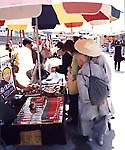 Actually the shopping was a big disappointment to me. I really expected to
see a fair bit of traditional crafts, and there's next to nothing. Lots of
people selling western clothes -- that's definitely the majority. Western
shoes are #2. I'd say there's easily two malls' worth of clothes and shoes.
Then you've got kitchen gadgets -- pots and pans, things to shine pots
and pans, Tupperware type stuff.
Actually the shopping was a big disappointment to me. I really expected to
see a fair bit of traditional crafts, and there's next to nothing. Lots of
people selling western clothes -- that's definitely the majority. Western
shoes are #2. I'd say there's easily two malls' worth of clothes and shoes.
Then you've got kitchen gadgets -- pots and pans, things to shine pots
and pans, Tupperware type stuff. 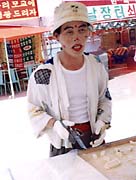
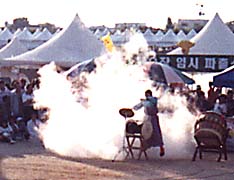

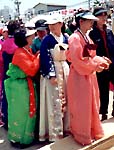 tomorrow. And I did pretty well from about 9 to 3, and then couldn't handle
the sitting on very hard, crowded ground any more. I had to get up and
walk around for a while. And walking around meant seeing all the stuff for
sale at such good prices, and you know how it is.
tomorrow. And I did pretty well from about 9 to 3, and then couldn't handle
the sitting on very hard, crowded ground any more. I had to get up and
walk around for a while. And walking around meant seeing all the stuff for
sale at such good prices, and you know how it is. 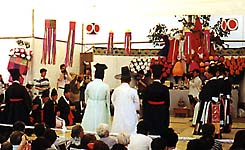


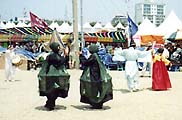 After a few dozen rejections she finally
accepted him, and they danced arm in arm. The good spirits imitated them on
one side, and the bad spirits imitated them on the other. Then the spirits
all started butting in, chasing the man off and dancing with the woman.
He'd come back, hit the spirit with his fan to make it go away, and
another one would take its place. Finally he had had enough of that, and (all
in pantomime remember) yelled at the woman for consorting with the
spirits.
After a few dozen rejections she finally
accepted him, and they danced arm in arm. The good spirits imitated them on
one side, and the bad spirits imitated them on the other. Then the spirits
all started butting in, chasing the man off and dancing with the woman.
He'd come back, hit the spirit with his fan to make it go away, and
another one would take its place. Finally he had had enough of that, and (all
in pantomime remember) yelled at the woman for consorting with the
spirits.  they were the man. Anyway he caught her with them again and hit her and
rejected her. (Sorry guys, but Korea's still that kind of society; probably have
Confucius to thank for it.) [Korea's sexism is generally ascribed to Confucianism, but
it's hard to be sure how much is Confucius and how much is Yul Guk, Korea's
revered Confucian scholar.
they were the man. Anyway he caught her with them again and hit her and
rejected her. (Sorry guys, but Korea's still that kind of society; probably have
Confucius to thank for it.) [Korea's sexism is generally ascribed to Confucianism, but
it's hard to be sure how much is Confucius and how much is Yul Guk, Korea's
revered Confucian scholar.
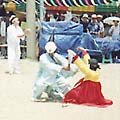
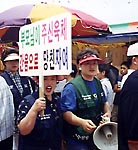
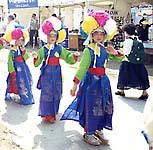 they danced out the planting, harvesting, and threshing of rice, and
making it into rice cakes.
The first group used props, and handed out rice
cakes to the audience. I think it was a competition, because various
judge-ish looking people talked when they were done, and then another group
started doing their version of it.
they danced out the planting, harvesting, and threshing of rice, and
making it into rice cakes.
The first group used props, and handed out rice
cakes to the audience. I think it was a competition, because various
judge-ish looking people talked when they were done, and then another group
started doing their version of it. 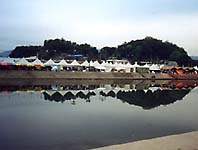 edge and thought I'd blown it. But Carol said that was OK, because the
rabbit wasn't broken. See, I thought you had to pop out the center
patterned part without breaking either part. So I just continued breaking
off the edge and actually got the whole rabbit out intact! As a prize, I
won a huge mug, about beer stein size. So I have an appropriately sized
coffee cup here for coffee-loving visitors.
edge and thought I'd blown it. But Carol said that was OK, because the
rabbit wasn't broken. See, I thought you had to pop out the center
patterned part without breaking either part. So I just continued breaking
off the edge and actually got the whole rabbit out intact! As a prize, I
won a huge mug, about beer stein size. So I have an appropriately sized
coffee cup here for coffee-loving visitors.